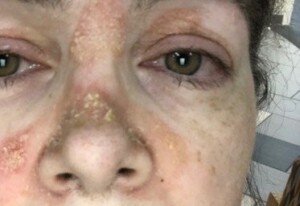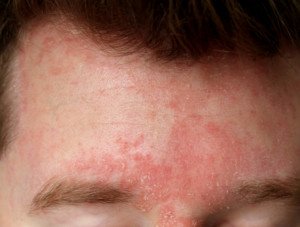
Itchy scaly and flaky skin above the eyelids—sometimes it even stings.
There are many causes, and the solution depends on the causes. The flaking and itchiness can seemingly come out of nowhere.
“Allergies, irritants, eczema and psoriasis can all contribute to dry scaly skin above your eyelids,” says Dr. Janet Prystowsky, who’s a board certified dermatologist in New York, NY, with 30+ years’ experience.
“Crusting along your lashes may be caused by seborrheic dermatitis.
“Bacteria, mites and fungi can also cause an infection known as blepharitis.”
However, crusting along the eyelids is a different situation than scaly itchy and flaky skin above the eyelids.
“If your dry eyelids are caused by eczema, psoriasis, or other chronic skin conditions, you will typically find patches elsewhere on the body as well,” says Dr. Prystowsky.
“For eczema and sometimes psoriasis, your doctor may prescribe an immunomodulator like Protopic or Elidel.
“It’s important to determine the cause of your eyelid irritation before determining an appropriate treatment.”
Allergies
Dr. Prystowsky names the following as causes: cosmetics, hair dye, nail polish, shampoo, cleansers, food, plants, glue, artificial lashes and eyelash curlers. “Medications and preservatives can also cause allergic reactions.
“Airborne allergens like dust and pollen could also contribute to eyelid irritation.
“Be sure to wash your hands often and avoid touching your face, to help minimize irritation.
“Stop using your facial beauty products if you suspect that you are having an allergic reaction.
“Your dermatologist may recommend a patch test to determine your allergy.
“In the meantime, avoid any possible triggers and practice proactive hygiene.”
Eye drops can also cause crusting of the eyelids where the skin meets the lashes, but will not cause that itchy scaly skin above the eyelids.
Most Likely Cause of Flaking, Itchy, Irritated Skin Above the Eyelids

Seborrheic dermatitis
It’s a good bet it’s seborrheic dermatitis (above image). Sometimes, seborrheic dermatitis causes stinging or a vague burning sensation.
Often there’s a slight redness or a peach colored irritation.
Seborrheic dermatitis almost always will not be limited to the skin above the eyelids, though this location may at times be the only area of flare-up.

Seborrheic dermatitis. Shutterstock/Dermatology11
Other common locations for seborrheic dermatitis are the area between and a little above the eyebrows, the eybrows, hairline, the crease on either side of the nose above the nostrils, the lower part of the nose, the ear canals and even the armpits.
If you’ve been diagnosed with seborrheic dermatitis, your dermatologist will suggest some treatments, but one that may work is a dandruff shampoo.
Your dermatologist will explain how to carefully apply it and rinse it off.
Here are more tips from Dr. Prystowsky for treating eyelid allergies.

In combination with her focus on early skin cancer detection and removal, Dr. Prystowsky provides a wide range of revitalizing and rejuvenating treatments.
 Lorra Garrick has been covering medical, fitness and cybersecurity topics for many years, having written thousands of articles for print magazines and websites, including as a ghostwriter. She’s also a former ACE-certified personal trainer.
Lorra Garrick has been covering medical, fitness and cybersecurity topics for many years, having written thousands of articles for print magazines and websites, including as a ghostwriter. She’s also a former ACE-certified personal trainer.
.


























